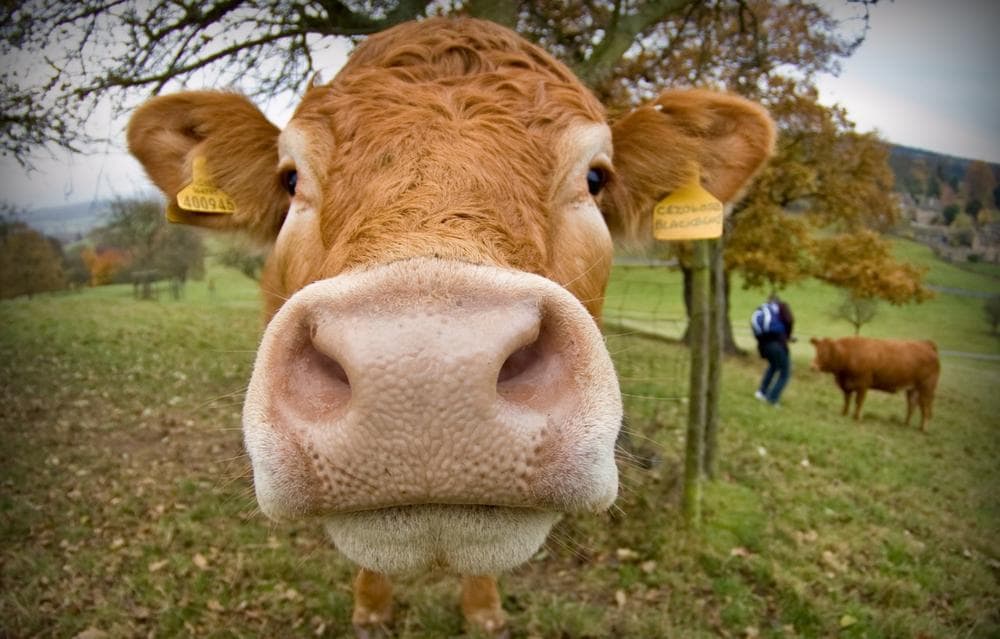Advertisement
Test Tube Burger: No Cows, No Greenhouse Gas
Resume
Advocates say red meat is a healthy source of protein and iron. Detractors say it's a major cause of health problems. A new study finds eating meat may be tied to diabetes, and other studies have linked it to colon cancer.
But what's not disputed is the environmental impact of consuming meat: a single burger requires 2500 liters of water to produce. And for every kilo of beef eaten, 35 kilograms of greenhouse gases — in the form of methane — are released.
Meat lovers find that meat substitutes leave a lot to be desired in the flavor and texture realms. But entrepreneurs are working hard to produce a new breed of meat substitutes that require cutting-edge technology. Other scientists have begun attempts to grow meat in test tubes.
The executive editor of IEEE Spectrum magazine, Glenn Zorpette, explores these new frontiers in fake meat, and some solutions to the environmental consequences in his articles, "The Better Meat Substitute" and "Half-Baked Ideas for Improving the Food Supply."
"This has been a decades-long quest. NASA funded some work on this in the ’80s."
Glenn Zorpette
HMMAs versus test tube meat
One fairly advanced category of fake meat is HMMAs, which stands for "high-moisture meat analogs." They're designed to have the mouth feel of real muscle meat. The companies that produce HMMAs include Beyond Meat and Plenti.
"I've tried them both. I was amazed at the texture. The texture just simply blew me away, how similar it was to chicken. Now, the flavor I think wasn't quite there for the Beyond Meat product," said Zorpette, noting that Beyond Meat comes in a variety of flavors, while the Plenti product is unflavored.
The cutting edge of substitute meat technology is in vitro meat — literally growing meat in laboratories.
"This has been a decades-long quest. NASA funded some work on this in the '80s," Zorpette said. "In fact, Winston Churchill had some ideas about this, and he wondered why we can't just make meat in a laboratory."
An anonymous billionaire is funding a researcher at the University of Mastricht who wants to create the world's first synthetic hamburger. It is estimated to cost $330,000 dollars.
"That may not sound like a big deal, but no one has ever made more than tiny, tiny bits of fake meat," Zorpette said. "The reason why it's so hard is because this is actual meat, so it's actual animal muscle that's grown in a laboratory."
Environmental concerns
There is no denying the environmental impact of raising animals. At some point, eating meat will become unsustainable, Zorpette said. Currently about 26 percent of the usable land on the planet is used for raising livestock, and the animals create enormous amount of greenhouse gasses — especially methane.
"Methane is an enormously powerful green house gas," Zorpette said. "It's a much more powerful greenhouse gas than carbon dioxide is."
Estimates vary for how much of greenhouse gas emissions come from animals, from 18 to as much as 50 percent. And the demand for meat will rise as population grows and the standard of living worldwide increases.
"People want to eat the way we do in the West — they want to eat meat," Zorpette said. "The world ate something like 302 million metric tons of meat last year. In 2050, when the population is supposed to hit something like 9 billion, that figure is predicted to rise to 465 million metric tons of meat," Zorpette said.
Eat less meat
But being environmentally conscious doesn't mean completely forgoing meat and animal products.
An environmentalist Zorpette spoke to said if a person substituted five percent of the animal protein in his or her diet with vegetable protein, it would have a huge environmental impact.
Zorpette himself only eats meat at lunch. "I find I don't really miss it other times of the day."
- See also: A Consumer’s Guide to Fake Meat (IEEE Spectrum)
Guest:
- Glenn Zorpette, executive editor of IEEE Spectrum Magazine.
This segment aired on June 20, 2013.